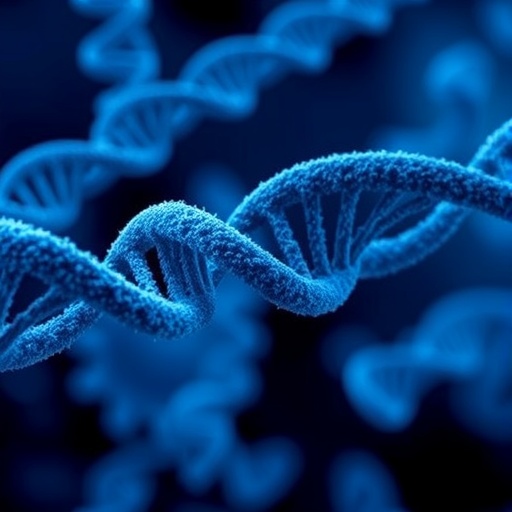In a groundbreaking advance that reshapes our understanding of human brain evolution, researchers at the University of California San Diego School of Medicine have uncovered critical molecular mechanisms that may explain what makes the human brain uniquely sophisticated. Their work focuses on a class of genomic elements known as human-accelerated regions, or HARs, which are segments of DNA that have undergone rapid mutation since our evolutionary divergence from chimpanzees roughly five million years ago. These regions are thought to play pivotal roles in the development of traits exclusive to Homo sapiens, particularly within the nervous system.
The investigative team centered their attention on one specific human-accelerated region designated HAR123. Unlike genes that encode proteins, HAR123 functions as a transcriptional enhancer—a molecular conductor that orchestrates the activation of target genes, modulating their expression levels and timing during development. This enhancer acts as a genomic volume control, fine-tuning when and how much certain genes prompt the formation and maturation of brain cells, ultimately influencing the architecture and complexity of the human brain.
What the scientists found was remarkable: HAR123 directly influences the proliferation of neural progenitor cells, a fundamental cell population in the brain’s developmental trajectory. These progenitors serve as a reservoir, differentiating into the primary cerebral cell types—neurons, responsible for processing and transmitting information, and glial cells, which provide critical support and protection to neurons. By regulating the balance and output of these cell types, HAR123 shapes the cellular composition of the brain, potentially endowing humans with advanced neurological functions.
Moreover, the subtle but critical modulation of neuron-to-glia ratios driven by HAR123 suggests that this enhancer impacts not just the quantity but the qualitative nature of brain tissue development. This fine balance is believed to underlie distinct cognitive capacities, including the uniquely human capacity for cognitive flexibility—a sophisticated cognitive ability that allows individuals to discard outdated information and adapt to new contexts and challenges, forming the bedrock of learning and problem-solving.
The evolutionary significance of HAR123 is underscored by comparative analyses between human and chimpanzee versions of this enhancer. Laboratory experiments using induced pluripotent stem cells and neuronal precursor cells cultured in vitro revealed stark differences in molecular and cellular behavior dependent on the species-specific HAR123 sequence. The human variant displayed heightened enhancer activity, which corresponded with increased neural progenitor proliferation and altered differentiation patterns, highlighting its instrumental role in human brain evolution.
These discoveries offer a tantalizing glimpse into the molecular underpinnings that have driven the expansive growth and complexity of the human neocortex over millions of years. Furthermore, HAR123 may constitute a critical node linking evolutionary biology with neurodevelopmental health. Given the enhancer’s influence on neural progenitors and cell-type ratios, aberrations in its function could conceivably contribute to developmental disorders including autism spectrum disorder (ASD), for which links to HARs have been proposed but remain inadequately understood.
Since transcriptional enhancers like HAR123 exert influence over gene regulatory networks rather than coding for proteins themselves, dissecting their exact mechanisms demands sophisticated genomic and epigenomic approaches. The research team employed advanced genetic editing tools, high-throughput sequencing, and stem cell differentiation assays to systematically reveal the enhancer’s regulatory dynamics. These methodologies enable scientists to map the cascade of gene expression changes and cellular outcomes initiated by enhancer activity, shedding light on how non-coding DNA can dramatically shape brain development.
Future research aims to delve deeper into the complex regulatory interactions in which HAR123 participates. Understanding how this enhancer interfaces with transcription factors and other components of the genomic regulatory landscape will be crucial to fully deciphering the molecular choreography that engenders human-specific brain features. Additionally, exploring the range of phenotypic effects driven by HAR123 variants could illuminate how genetic diversity within human populations influences cognitive traits and susceptibility to neurodevelopmental conditions.
This pioneering study, published in the journal Science Advances, was led by Miles Wilkinson and Kun Tan, both distinguished scientists within the UC San Diego Department of Obstetrics, Gynecology, and Reproductive Sciences. Their collaborative effort bridges the gap between evolutionary genetics and neurobiology, underscoring the interdisciplinary nature of uncovering human uniqueness. The work was supported by grants from the National Institutes of Health and private sector partners like 10x Genomics, exemplifying the synergy between fundamental science and cutting-edge technology.
In a broader context, the findings about HAR123 reinforce the paradigm that the evolutionary trajectory of human cognition is driven not only by changes in protein-coding genes but crucially by alterations in the regulatory genome. Such modifications permit nuanced spatial and temporal control of gene expression, allowing for complex developmental programs that carve out the structural and functional sophistication of the human brain. This regulatory genome evolution thus emerges as a fundamental contributor to what distinguishes humans from other primates.
As the scientific community continues to unravel the genomic mysteries coded within HARs, HAR123 stands out as a powerful example of how subtle genetic modifications can ripple outward to produce monumental biological outcomes. Its influence on brain cell development and cognitive flexibility positions it as a potential key piece in the evolutionary puzzle and as a promising avenue for medical research into conditions that affect neurodevelopment. With further investigation, insights garnered from HAR123 could pave the way for novel therapeutic strategies targeting gene regulation to ameliorate or even prevent neurodevelopmental disorders.
Subject of Research: Human brain evolution and genomic regulatory elements
Article Title: The Molecular Evolution of HAR123: A Human-Accelerated Enhancer Shaping Brain Development and Cognitive Flexibility
Web References: http://dx.doi.org/10.1126/sciadv.adt0534
Keywords: Genetics, Developmental neuroscience, Autism, Human-accelerated regions, Transcriptional enhancers, Neural progenitor cells, Cognitive flexibility, Neurodevelopmental disorders




